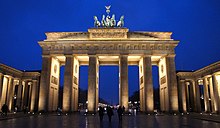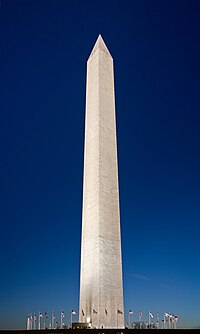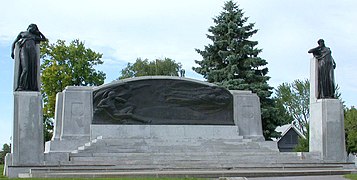Monument

A monument is a type of structure that was explicitly created to commemorate a person or event, or which has become relevant to a social group as a part of their remembrance of historic times or cultural heritage, due to its artistic, historical, political, technical or architectural importance.[1] Examples of monuments include statues, (war) memorials, historical buildings, archaeological sites, and cultural assets. If there is a public interest in its preservation, a monument can for example be listed as a UNESCO World Heritage Site.[2] The Palgrave Encyclopedia of Cultural Heritage and Conflict gives the next definition of monument:
Monuments result from social practices of construction or conservation of material artifacts through which the ideology of their promoters is manifested. The concept of the modern monument emerged with the development of capital and the nation-state in the fifteenth century when the ruling classes began to build and conserve what were termed monuments. These practices proliferated significantly in the nineteenth century, creating the ideological frameworks for their conservation as a universal humanist duty. The twentieth century has marked a movement toward some monuments being conceived as cultural heritage in the form of remains to be preserved, and concerning commemorative monuments, there has been a shift toward the abstract counter monument. In both cases, their conflictive nature is explicit in the need for their conservation, given that a fundamental component of state action following the construction or declaration of monuments is litigating vandalism and iconoclasm. However, not all monuments represent the interests of nation-states and the ruling classes; their forms are also employed beyond Western borders and by social movements as part of subversive practices which use monuments as a means of expression, where forms previously exclusive to European elites are used by new social groups or for generating anti-monumental artifacts that directly challenge the state and the ruling classes. In conflicts, therefore, it is not so much the monument which is relevant but rather what happens to the communities that participate in its construction or destruction and their instigation of forms of social interaction.[3]
Etymology
[edit]The word "monument" comes from the Latin "monumentum", derived from the word moneo, monere, which means 'to remind' or 'to warn', suggesting a monument allows us to see the past thus helping us visualize what is to come in the future.[4] In English the word "monumental" is often used in reference to something of extraordinary size and power, as in monumental sculpture, but also to mean simply anything made to commemorate the dead, as a funerary monument or other example of funerary art.
Creation and functions
[edit]A formalist interpretation of monuments suggests their origins date back to antiquity and even prehistory. Archaeologists like Gordon Childe viewed ancient monuments as symbols of power. Historians such as Lewis Mumford proposed that the practice began with Paleolithic landmarks, which served as sites for communication with ancestral spirits. However, these perspectives often project modern uses of monuments onto ancient structures. In art history, monuments are seen as significant sculptural forms; in architecture and urban planning, they are crucial for city organization and mapping. These contemporary interpretations have been retroactively applied to ancient and non-Western structures. This modern concept of monuments aligns with how past constructions are labeled as monuments today. Françóise Choay highlights the distinction between these views: "The historic monument is a precisely datable invention of the West... exported and diffused beyond Europe from the late nineteenth century."[5] Basically, the definition framework of the term monument depends on the current historical frame conditions. Aspects of the Culture of Remembrance and cultural memory are also linked to it, as well as questions about the concepts of public sphere and durability (of the one memorized) and the form and content of the monument (work-like monument). From an art historical point of view, the dichotomy of content and form opens up the problem of the "linguistic ability" of the monument. It becomes clear that language is an eminent part of a monument and it is often represented in "non-objective" or "architectural monuments", at least with a plaque. In this connection, the debate touches on the social mechanisms that combine with Remembrance. These are acceptance of the monument as an object, the conveyed contents and the impact of these contents.
Monuments are frequently used to improve the appearance of a city or location. Planned cities such as Washington, D.C., New Delhi and Brasília are often built around monuments. For example, the Washington Monument's location was conceived by L'Enfant to help organize public space in the city, before it was designed or constructed. Older cities have monuments placed at locations that are already important or are sometimes redesigned to focus on one. As Shelley suggested in his famous poem "Ozymandias" ("Look on my works, ye Mighty, and despair!"), the purpose of monuments is very often to impress or awe.
Structures created for other purposes that have been made notable by their age, size or historic significance may also be regarded as monuments. This can happen because of great age and size, as in the case of the Great Wall of China, or because an event of great importance occurred there such as the village of Oradour-sur-Glane in France. Many countries use 'ancient monument' or similar terms for the official designation of protected structures or archeological sites which may originally have been ordinary domestic houses or other buildings.
Monuments are also often designed to convey historical or political information, and they can thus develop an active socio-political potency. They can be used to reinforce the primacy of contemporary political power, such as the column of Trajan or the numerous statues of Lenin in the Soviet Union. They can be used to educate the populace about important events or figures from the past, such as in the renaming of the old General Post Office Building in New York City to the James A. Farley Building, after James Farley, former Postmaster General of the United States.[6] To fulfill its informative and educative functions a monument needs to be open to the public, which means that its spatial dimension, as well as its content can be experienced by the public, and be sustainable. The former may be achieved either by situating the monument in public space or by a public discussion about the monument and its meaning, the latter by the materiality of the monument or if its content immediately becomes part of the collective or cultural memory.
The social meanings of monuments are rarely fixed and certain and are frequently 'contested' by different social groups. As an example: whilst the former East German socialist state may have seen the Berlin Wall as a means of 'protection' from the ideological impurity of the west, dissidents and others would often argue that it was symbolic of the inherent repression and paranoia of that state. This contention of meaning is a central theme of modern 'post processual' archaeological discourse.
Loss and destruction
[edit]While many ancient monuments still exist today, there are notable incidents of monuments being intentionally or accidentally destroyed and many monuments are likely to have disappeared through the passage of time and natural forces such as erosion. In 772 during the Saxon Wars, Charlemagne intentionally destroyed an Irminsul monument[7] in order to desecrate the pagan religion. In 1687 the Parthenon in Athens was partially destroyed by a Venetian mortar round, which set off the store of gunpowder kept there by the Turkish defenders.[8]
A recent archeological dig in central France uncovered the remains of a Megalithic monument that had been previously destroyed "Like some monuments, including Belz in Morbihan, the menhirs of Veyre-Monton were knocked down in order to make them disappear from the landscape. Pushed into large pits, sometimes mutilated or covered with earth, these monoliths have been destroyed. 'object of iconoclastic gestures, a sort of condemnation perhaps linked to some change of community or beliefs "[9][10]
Protection and preservation
[edit]The term is often used to describe any structure that is a significant and legally protected historic work, and many countries have equivalents of what is called in United Kingdom legislation a Scheduled Monument, which often include relatively recent buildings constructed for residential or industrial purposes, with no thought at the time that they would come to be regarded as "monuments".
Until recently, it was customary for archaeologists to study large monuments and pay less attention to the everyday lives of the societies that created them. New ideas about what constitutes the archaeological record have revealed that certain legislative and theoretical approaches to the subject are too focused on earlier definitions of monuments. An example has been the United Kingdom's Scheduled Ancient Monument laws.
Other than municipal or national government that protecting the monuments in their jurisdiction, there are institutions dedicated on the efforts to protect and preserve monuments that considered to possess special natural or cultural significance for the world, such as UNESCO's World Heritage Site programme[11] and World Monuments Fund.[2]
Cultural monuments are also considered to be the memory of a community and are therefore particularly at risk in the context of modern asymmetrical warfare. The enemy's cultural heritage is to be sustainably damaged or even destroyed. In addition to the national protection of cultural monuments, international organizations (cf. UNESCO World Heritage, Blue Shield International) therefore try to protect cultural monuments.[12][13][14][15]
Recently, more and more monuments are being preserved digitally (in 3D models) through organisations as CyArk.[16]
Types
[edit]
- Benchmarks placed by a government agency or private survey firm.
- Buildings designed as landmarks, usually built with an extraordinary feature, such being designed as the tallest, largest, or most distinctive design, e.g., the Burj Khalifa in Dubai, the world's tallest structure or the One World Trade Center, the tallest building in the United States, built to memorialize the attack on September 11.
- Cenotaphs (intended to honour the dead who are buried elsewhere) and other memorials to commemorate the dead, usually war casualties, e.g., India Gate and Vimy Ridge Memorial, or disaster casualties, such as the Titanic Memorial, Belfast.
- Church monuments to commemorate the faithful dead, located above or near their grave, often featuring an effigy, e.g., St. Peter's Basilica or the medieval church Sta Maria di Collemaggio in L'Aquila.
- Columns, often topped with a statue, e.g., Berlin Victory Column, Nelson's Column in London, and Trajan's Column in Rome.
- Eternal flames that are kept burning continuously, usually lit to honor unknown soldiers, e.g., at the Tomb of Unknown Soldier in Moscow or at the John F. Kennedy gravesite in Virginia's Arlington National Cemetery.

The Washington Monument in Washington, D.C., which honors the first president of the United States, George Washington, is the world's tallest obelisk.

- Fountains, water-pouring structures usually placed in formal gardens or town squares, e.g., Fontaines de la Concorde and Gardens of Versailles.
- Gravestones, small monuments to the deceased, placed at their gravesites, e.g., the tombs and vaults of veterans in Les Invalides and Srebrenica Genocide Memorial.
- Mausoleums and tombs to honor the dead, e.g., the Great Pyramid of Giza, Libyco-Punic Mausoleum of Dougga and Taj Mahal.
- Monoliths erected for religious or commemorative purposes, e.g., Stonehenge.
- Mosque Monuments, places of worship that generally have domes and minarets that stand out against the skyline. They also usually feature highly skilled Islamic calligraphy and geometric artwork, e.g., the Mosque of the Prophet.
- Mounds erected to commemorate great leaders or events, e.g., Kościuszko Mound.
- Obelisks, usually erected to commemorate great leaders, e.g., Cleopatra's Needle in London, the National Monument ("Monas") in Central Jakarta, and the Washington Monument in Washington, D.C.
- Palaces, imposing royal residences designed to impress people with their grandeur and greatness, e.g., Forbidden City in Beijing, Palace of Versailles, and Schwerin Palace in Schwerin.
- Searchlights to project a powerful beam of light, e.g., Tribute in Light in the National September 11 Memorial & Museum in New York City, commemorating the September 11 attacks of 2001.
- Statues of famous individuals or symbols, e.g., the Niederwalddenkmal (Germania) in Hesse, Liberty Enlightening the World (commonly known as the Statue of Liberty) in New York City, and The Motherland Calls in Volgograd.
- Temples or religious structures built for pilgrimage, ritual or commemorative purposes, e.g., Borobudur in Magelang and Kaaba in Mecca.
- Terminating Vistas, layout design for urban monuments on the end of an avenue, e.g., Opera Garnier in Paris.
- Triumphal arches, almost always to commemorate military successes, e.g., the Arch of Constantine in Rome and Arc de Triomphe de l'Étoile in Paris.
- War memorials, e.g., the Iwo Jima Memorial in Arlington, VA, the Laboe Naval Memorial, the Lorraine American Cemetery and Memorial in St Avold,[17] and the Soviet War Memorial in Berlin.
Examples of notable monuments
[edit]-
The Statue of Liberty (Liberty Enlightening the World), the symbol of the United States' freedom
-
The Maqam Echahid, in Algiers, iconic concrete monument commemorating the Algerian war for independence
-
Chairman Mao Memorial Hall is located on the Tiananmen Square, where the Beijing Gate of China used to stand
-
The Bell Telephone Memorial, commemorates the invention of the telephone, Brantford, Ontario
-
The Hiroshima Cenotaph and Atomic Bomb Dome to remember the victims of August 6, 1945 atomic bombing
See also
[edit]- Antiquities Act
- English Heritage Archive, holds data on England's monuments
- Memorial
- Monumental sculpture
- National memorial
- National monument
References
[edit]- ^ Caves, R. W. (2004). Encyclopedia of the City. Routledge. p. 470. ISBN 978-0415252256.
- ^ a b "Preserving Cultural Heritages". wmf.org. World Monument Fund. Retrieved 2013-10-23.
- ^ Palacios González, Daniel (2020), Saloul, Ihab; Baillie, Britt (eds.), "Monument", The Palgrave Encyclopedia of Cultural Heritage and Conflict, Cham: Springer International Publishing, pp. 1–13, doi:10.1007/978-3-030-61493-5_23-1, ISBN 978-3-030-61493-5, retrieved 2024-03-08
- ^ John Young Cole; Henry Hope Reed (1997). The Library of Congress: The Art and Architecture of the Thomas Jefferson Building. Norton. p. 16. ISBN 978-0-393-04563-5.
- ^ Choay, Françoise (2001). The invention of the historic monument. Cambridge: Cambridge University Press.
- ^ David Gardner Chardavoyne (2012), United States District Court for the Eastern District of Michigan: People, Law, and Politics, Wayne State University Press, p. 194
- ^ Unknown; Scholz, Bernhard Walter; Rogers, Barbara (1972). "Chapter 772". Carolingian chronicles: Royal Frankish annals and Nithard's Histories. Translated by Bernhard Walter Scholz, with Barbara Rogers., . Ann Arbor: University of Michigan Press. pp. 48–49. ISBN 0-472-06186-0. Retrieved 24 July 2021.
- ^ Mommsen, Theodor E. (1941). "The Venetians in Athens and the Destruction of the Parthenon in 1687". American Journal of Archaeology. 45 (4): 544–556. doi:10.2307/499533. ISSN 0002-9114. JSTOR 499533. S2CID 191393528.
- ^ "Rare prehistoric stones discovered in central France".
- ^ "Découverte exceptionnelle d'une trentaine de monolithes préhistoriques en Auvergne". 26 August 2019.
- ^ "World Heritage". unesco.org.
- ^ "UNESCO Legal Instruments: Second Protocol to the Hague Convention of 1954 for the Protection of Cultural Property in the Event of Armed Conflict 1999".
- ^ Roger O’Keefe, Camille Péron, Tofig Musayev, Gianluca Ferrari "Protection of Cultural Property. Military Manual." UNESCO, 2016, S. 73ff.
- ^ UNESCO Director-General calls for stronger cooperation for heritage protection at the Blue Shield International General Assembly. UNESCO, 13 September 2017.
- ^ "Blue Shield Missions". Blue Shield International.
- ^ CyArk preserving monuments digitally. slashgear.com. October 22, 2013
- ^ "Lorraine American Cemetery and Memorial". abmc.gov. January 1960.
Further reading
[edit]- Chaney, Edward. 'Egypt in England and America: The Cultural Memorials of Religion, Royalty and Revolution', Sites of Exchange: European Crossroads and Faultines, ed. M. Ascari and A. Corrado, Amsterdam & New York, Rodopi, 2006, 39–6.
- Choay, Françoise (2001). The invention of the historic monument. Cambridge University Press.
- Gangopadhyay, Subinoy (2002). Testimony of Stone : Monuments of India. Dasgupta & Co.
- Phillips, Cynthia; Priwer, Shana (2008). Ancient Monuments. M E Sharpe Reference.
- Stierlin, Henri (2005). Great monuments of the ancient world. Thames & Hudson.
- Judith Dupre. Monuments: America's History in Art and Memory (2007). Random House. ISBN 978-1-4000-6582-0













